Management and Organizational Change
VerifiedAdded on 2023/06/15
|11
|2807
|261
AI Summary
This essay discusses the impact of organizational change on organizations and the tools that can be used for effective change management. The focus is on Total Quality Management and High Performance Work Organization. It also discusses the implementation of these tools in the manufacturing a...
Read More
Contribute Materials
Your contribution can guide someone’s learning journey. Share your
documents today.

Running head: MANAGEMENT AND ORGANIZATIONAL CHANGE
Management and Organizational Change
Name of the Student
Name of the University
Author Note
Management and Organizational Change
Name of the Student
Name of the University
Author Note
Secure Best Marks with AI Grader
Need help grading? Try our AI Grader for instant feedback on your assignments.
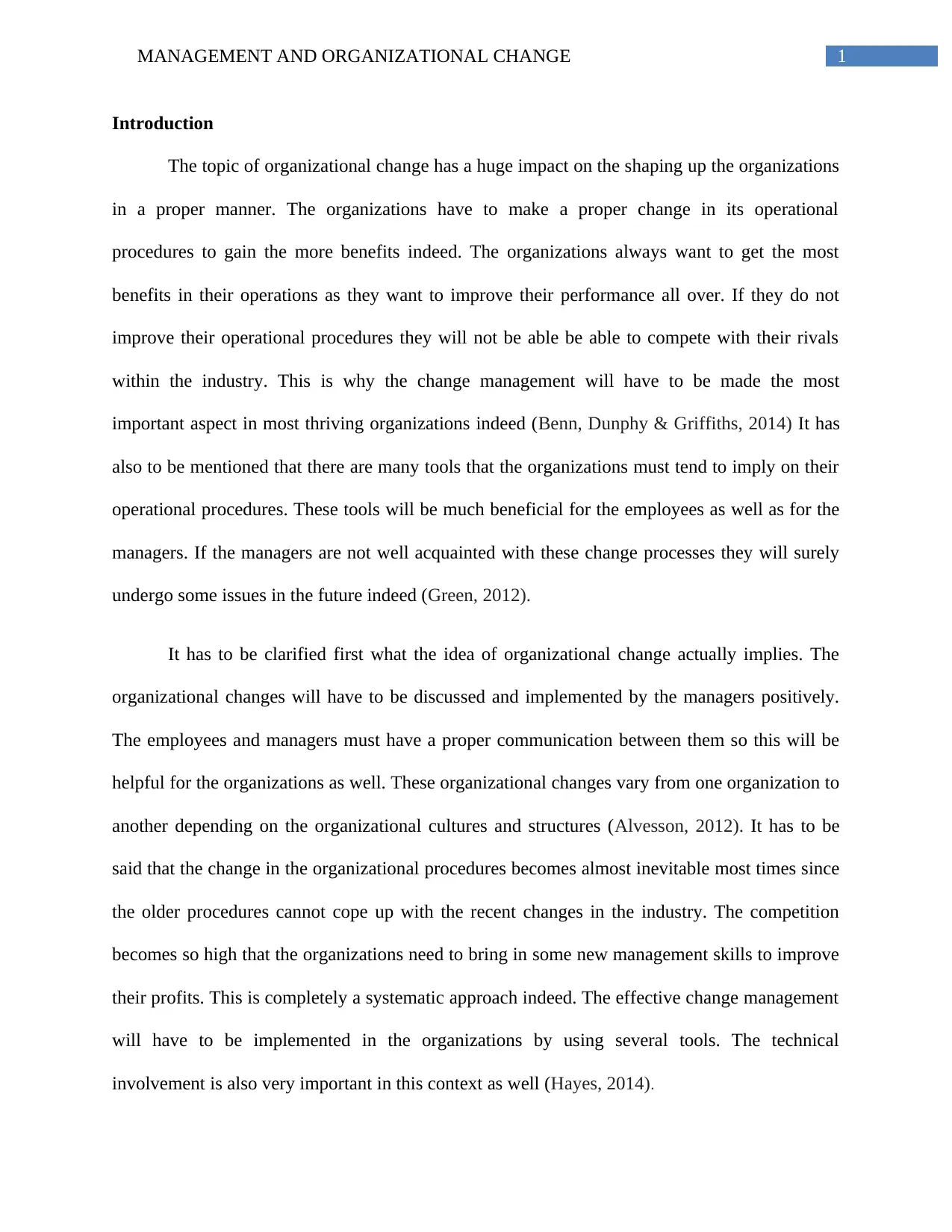
1MANAGEMENT AND ORGANIZATIONAL CHANGE
Introduction
The topic of organizational change has a huge impact on the shaping up the organizations
in a proper manner. The organizations have to make a proper change in its operational
procedures to gain the more benefits indeed. The organizations always want to get the most
benefits in their operations as they want to improve their performance all over. If they do not
improve their operational procedures they will not be able be able to compete with their rivals
within the industry. This is why the change management will have to be made the most
important aspect in most thriving organizations indeed (Benn, Dunphy & Griffiths, 2014) It has
also to be mentioned that there are many tools that the organizations must tend to imply on their
operational procedures. These tools will be much beneficial for the employees as well as for the
managers. If the managers are not well acquainted with these change processes they will surely
undergo some issues in the future indeed (Green, 2012).
It has to be clarified first what the idea of organizational change actually implies. The
organizational changes will have to be discussed and implemented by the managers positively.
The employees and managers must have a proper communication between them so this will be
helpful for the organizations as well. These organizational changes vary from one organization to
another depending on the organizational cultures and structures (Alvesson, 2012). It has to be
said that the change in the organizational procedures becomes almost inevitable most times since
the older procedures cannot cope up with the recent changes in the industry. The competition
becomes so high that the organizations need to bring in some new management skills to improve
their profits. This is completely a systematic approach indeed. The effective change management
will have to be implemented in the organizations by using several tools. The technical
involvement is also very important in this context as well (Hayes, 2014).
Introduction
The topic of organizational change has a huge impact on the shaping up the organizations
in a proper manner. The organizations have to make a proper change in its operational
procedures to gain the more benefits indeed. The organizations always want to get the most
benefits in their operations as they want to improve their performance all over. If they do not
improve their operational procedures they will not be able be able to compete with their rivals
within the industry. This is why the change management will have to be made the most
important aspect in most thriving organizations indeed (Benn, Dunphy & Griffiths, 2014) It has
also to be mentioned that there are many tools that the organizations must tend to imply on their
operational procedures. These tools will be much beneficial for the employees as well as for the
managers. If the managers are not well acquainted with these change processes they will surely
undergo some issues in the future indeed (Green, 2012).
It has to be clarified first what the idea of organizational change actually implies. The
organizational changes will have to be discussed and implemented by the managers positively.
The employees and managers must have a proper communication between them so this will be
helpful for the organizations as well. These organizational changes vary from one organization to
another depending on the organizational cultures and structures (Alvesson, 2012). It has to be
said that the change in the organizational procedures becomes almost inevitable most times since
the older procedures cannot cope up with the recent changes in the industry. The competition
becomes so high that the organizations need to bring in some new management skills to improve
their profits. This is completely a systematic approach indeed. The effective change management
will have to be implemented in the organizations by using several tools. The technical
involvement is also very important in this context as well (Hayes, 2014).
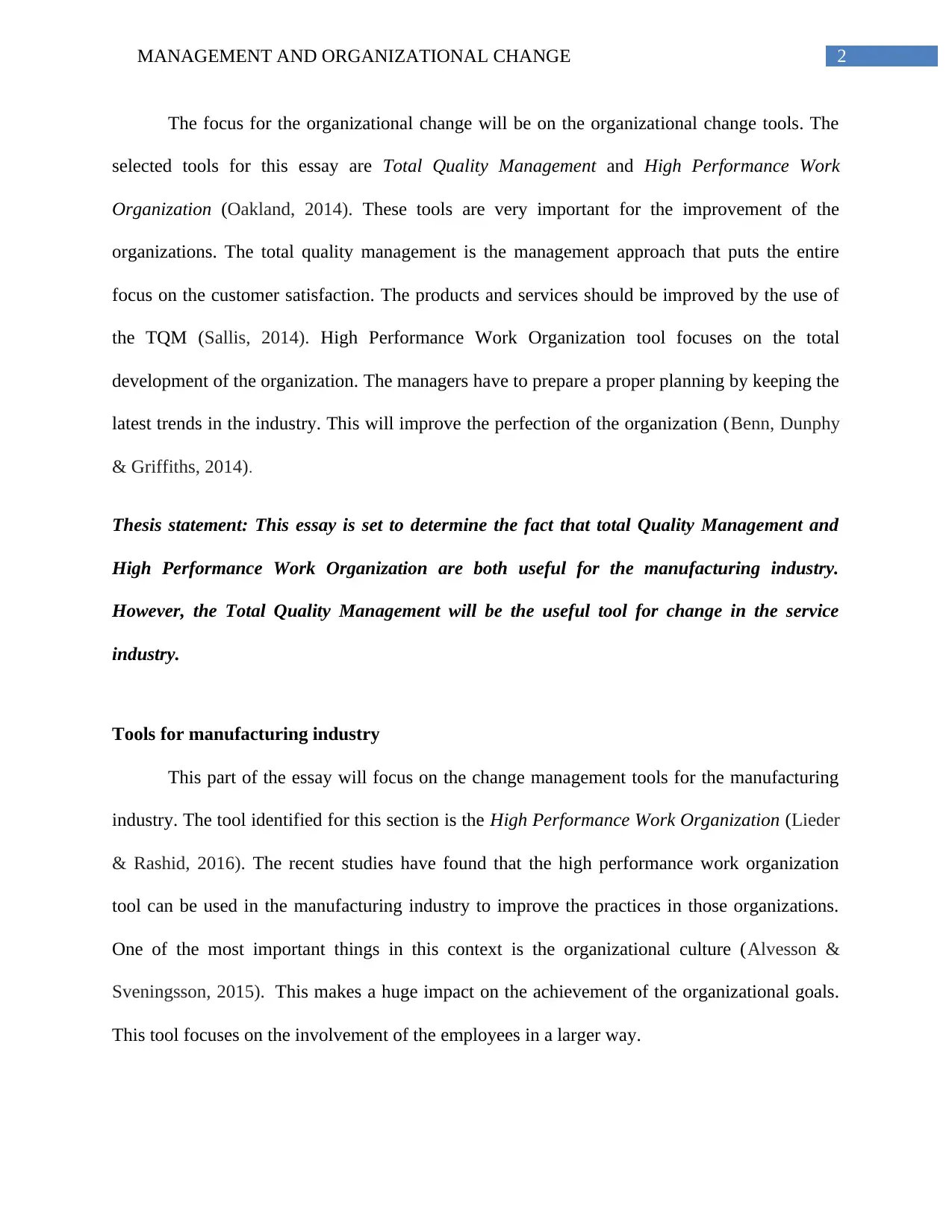
2MANAGEMENT AND ORGANIZATIONAL CHANGE
The focus for the organizational change will be on the organizational change tools. The
selected tools for this essay are Total Quality Management and High Performance Work
Organization (Oakland, 2014). These tools are very important for the improvement of the
organizations. The total quality management is the management approach that puts the entire
focus on the customer satisfaction. The products and services should be improved by the use of
the TQM (Sallis, 2014). High Performance Work Organization tool focuses on the total
development of the organization. The managers have to prepare a proper planning by keeping the
latest trends in the industry. This will improve the perfection of the organization (Benn, Dunphy
& Griffiths, 2014).
Thesis statement: This essay is set to determine the fact that total Quality Management and
High Performance Work Organization are both useful for the manufacturing industry.
However, the Total Quality Management will be the useful tool for change in the service
industry.
Tools for manufacturing industry
This part of the essay will focus on the change management tools for the manufacturing
industry. The tool identified for this section is the High Performance Work Organization (Lieder
& Rashid, 2016). The recent studies have found that the high performance work organization
tool can be used in the manufacturing industry to improve the practices in those organizations.
One of the most important things in this context is the organizational culture (Alvesson &
Sveningsson, 2015). This makes a huge impact on the achievement of the organizational goals.
This tool focuses on the involvement of the employees in a larger way.
The focus for the organizational change will be on the organizational change tools. The
selected tools for this essay are Total Quality Management and High Performance Work
Organization (Oakland, 2014). These tools are very important for the improvement of the
organizations. The total quality management is the management approach that puts the entire
focus on the customer satisfaction. The products and services should be improved by the use of
the TQM (Sallis, 2014). High Performance Work Organization tool focuses on the total
development of the organization. The managers have to prepare a proper planning by keeping the
latest trends in the industry. This will improve the perfection of the organization (Benn, Dunphy
& Griffiths, 2014).
Thesis statement: This essay is set to determine the fact that total Quality Management and
High Performance Work Organization are both useful for the manufacturing industry.
However, the Total Quality Management will be the useful tool for change in the service
industry.
Tools for manufacturing industry
This part of the essay will focus on the change management tools for the manufacturing
industry. The tool identified for this section is the High Performance Work Organization (Lieder
& Rashid, 2016). The recent studies have found that the high performance work organization
tool can be used in the manufacturing industry to improve the practices in those organizations.
One of the most important things in this context is the organizational culture (Alvesson &
Sveningsson, 2015). This makes a huge impact on the achievement of the organizational goals.
This tool focuses on the involvement of the employees in a larger way.
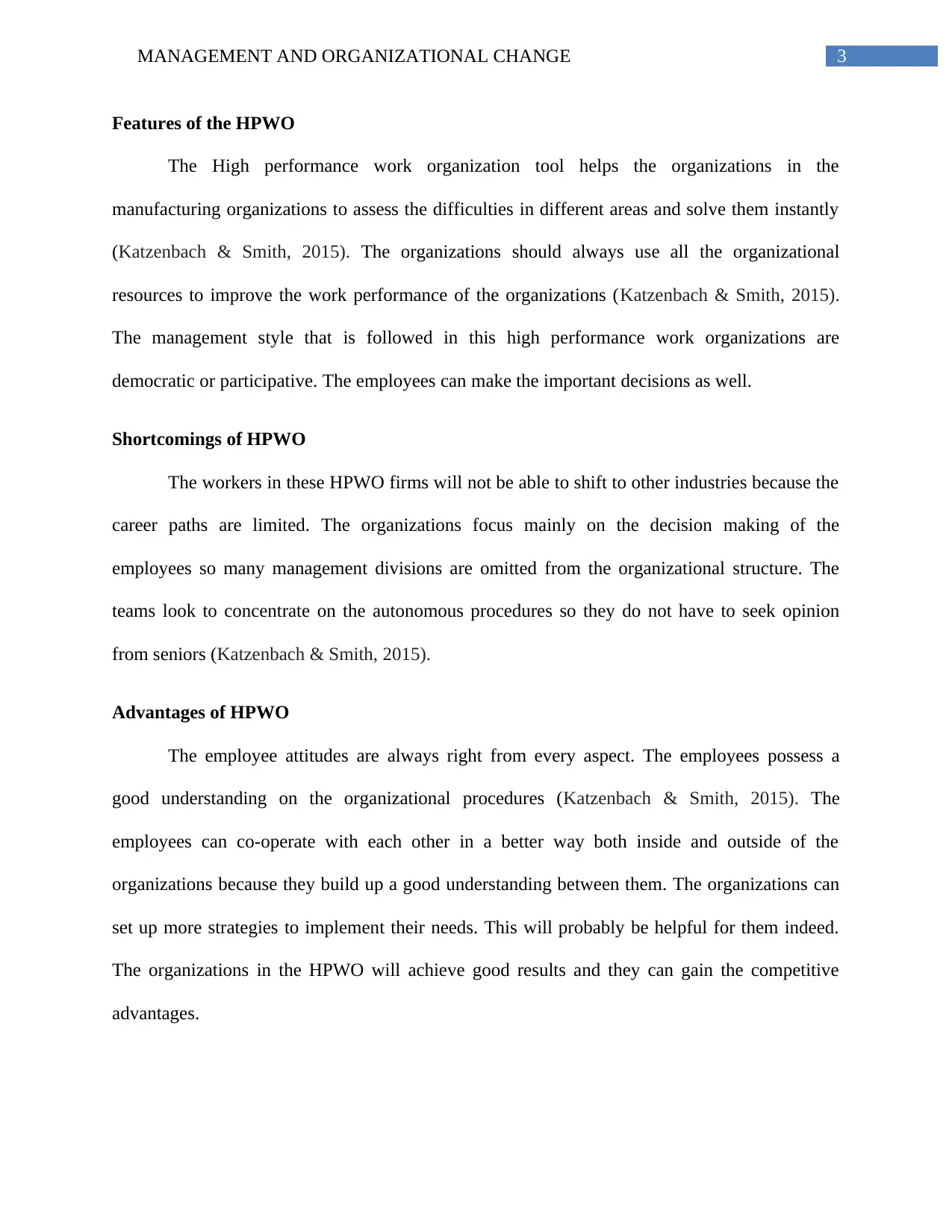
3MANAGEMENT AND ORGANIZATIONAL CHANGE
Features of the HPWO
The High performance work organization tool helps the organizations in the
manufacturing organizations to assess the difficulties in different areas and solve them instantly
(Katzenbach & Smith, 2015). The organizations should always use all the organizational
resources to improve the work performance of the organizations (Katzenbach & Smith, 2015).
The management style that is followed in this high performance work organizations are
democratic or participative. The employees can make the important decisions as well.
Shortcomings of HPWO
The workers in these HPWO firms will not be able to shift to other industries because the
career paths are limited. The organizations focus mainly on the decision making of the
employees so many management divisions are omitted from the organizational structure. The
teams look to concentrate on the autonomous procedures so they do not have to seek opinion
from seniors (Katzenbach & Smith, 2015).
Advantages of HPWO
The employee attitudes are always right from every aspect. The employees possess a
good understanding on the organizational procedures (Katzenbach & Smith, 2015). The
employees can co-operate with each other in a better way both inside and outside of the
organizations because they build up a good understanding between them. The organizations can
set up more strategies to implement their needs. This will probably be helpful for them indeed.
The organizations in the HPWO will achieve good results and they can gain the competitive
advantages.
Features of the HPWO
The High performance work organization tool helps the organizations in the
manufacturing organizations to assess the difficulties in different areas and solve them instantly
(Katzenbach & Smith, 2015). The organizations should always use all the organizational
resources to improve the work performance of the organizations (Katzenbach & Smith, 2015).
The management style that is followed in this high performance work organizations are
democratic or participative. The employees can make the important decisions as well.
Shortcomings of HPWO
The workers in these HPWO firms will not be able to shift to other industries because the
career paths are limited. The organizations focus mainly on the decision making of the
employees so many management divisions are omitted from the organizational structure. The
teams look to concentrate on the autonomous procedures so they do not have to seek opinion
from seniors (Katzenbach & Smith, 2015).
Advantages of HPWO
The employee attitudes are always right from every aspect. The employees possess a
good understanding on the organizational procedures (Katzenbach & Smith, 2015). The
employees can co-operate with each other in a better way both inside and outside of the
organizations because they build up a good understanding between them. The organizations can
set up more strategies to implement their needs. This will probably be helpful for them indeed.
The organizations in the HPWO will achieve good results and they can gain the competitive
advantages.
Secure Best Marks with AI Grader
Need help grading? Try our AI Grader for instant feedback on your assignments.
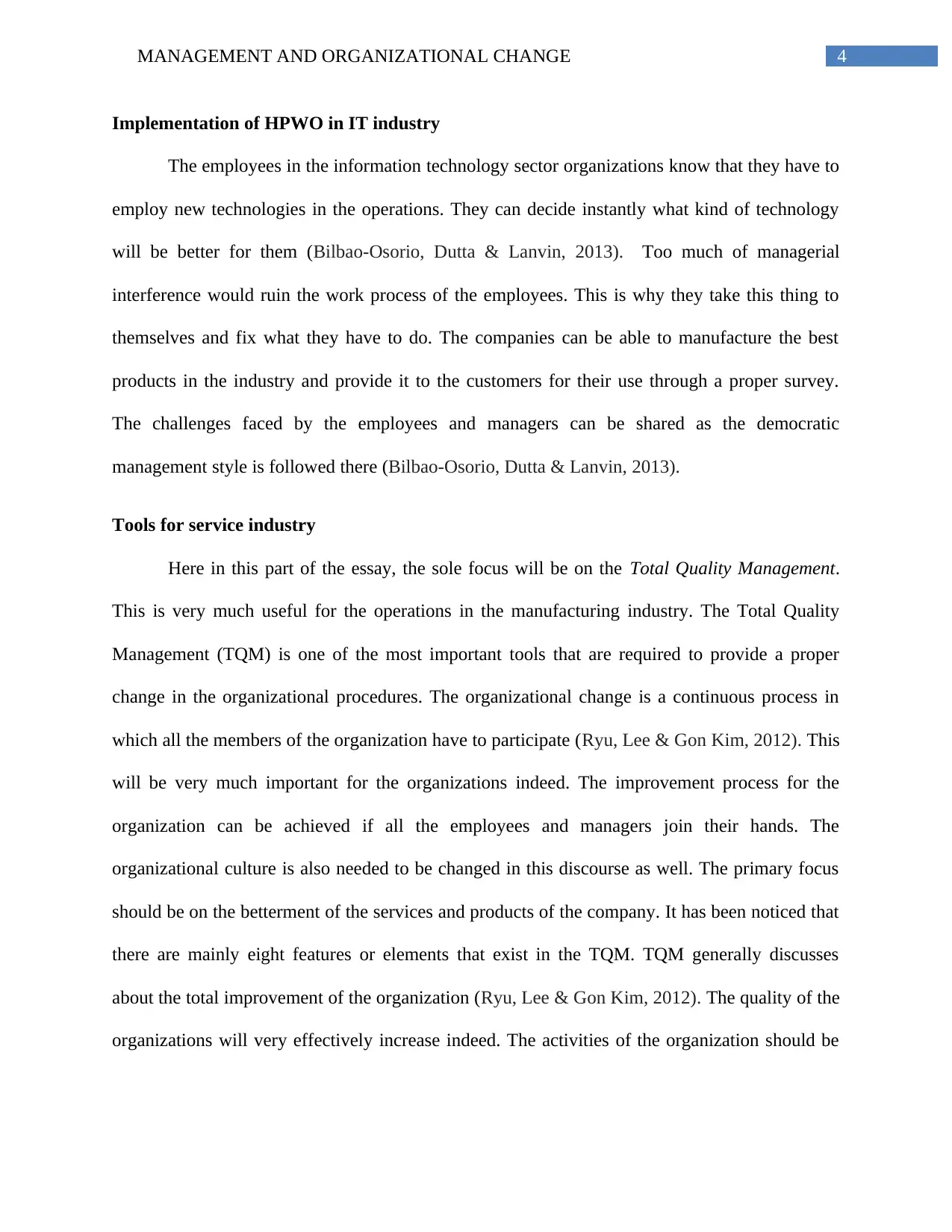
4MANAGEMENT AND ORGANIZATIONAL CHANGE
Implementation of HPWO in IT industry
The employees in the information technology sector organizations know that they have to
employ new technologies in the operations. They can decide instantly what kind of technology
will be better for them (Bilbao-Osorio, Dutta & Lanvin, 2013). Too much of managerial
interference would ruin the work process of the employees. This is why they take this thing to
themselves and fix what they have to do. The companies can be able to manufacture the best
products in the industry and provide it to the customers for their use through a proper survey.
The challenges faced by the employees and managers can be shared as the democratic
management style is followed there (Bilbao-Osorio, Dutta & Lanvin, 2013).
Tools for service industry
Here in this part of the essay, the sole focus will be on the Total Quality Management.
This is very much useful for the operations in the manufacturing industry. The Total Quality
Management (TQM) is one of the most important tools that are required to provide a proper
change in the organizational procedures. The organizational change is a continuous process in
which all the members of the organization have to participate (Ryu, Lee & Gon Kim, 2012). This
will be very much important for the organizations indeed. The improvement process for the
organization can be achieved if all the employees and managers join their hands. The
organizational culture is also needed to be changed in this discourse as well. The primary focus
should be on the betterment of the services and products of the company. It has been noticed that
there are mainly eight features or elements that exist in the TQM. TQM generally discusses
about the total improvement of the organization (Ryu, Lee & Gon Kim, 2012). The quality of the
organizations will very effectively increase indeed. The activities of the organization should be
Implementation of HPWO in IT industry
The employees in the information technology sector organizations know that they have to
employ new technologies in the operations. They can decide instantly what kind of technology
will be better for them (Bilbao-Osorio, Dutta & Lanvin, 2013). Too much of managerial
interference would ruin the work process of the employees. This is why they take this thing to
themselves and fix what they have to do. The companies can be able to manufacture the best
products in the industry and provide it to the customers for their use through a proper survey.
The challenges faced by the employees and managers can be shared as the democratic
management style is followed there (Bilbao-Osorio, Dutta & Lanvin, 2013).
Tools for service industry
Here in this part of the essay, the sole focus will be on the Total Quality Management.
This is very much useful for the operations in the manufacturing industry. The Total Quality
Management (TQM) is one of the most important tools that are required to provide a proper
change in the organizational procedures. The organizational change is a continuous process in
which all the members of the organization have to participate (Ryu, Lee & Gon Kim, 2012). This
will be very much important for the organizations indeed. The improvement process for the
organization can be achieved if all the employees and managers join their hands. The
organizational culture is also needed to be changed in this discourse as well. The primary focus
should be on the betterment of the services and products of the company. It has been noticed that
there are mainly eight features or elements that exist in the TQM. TQM generally discusses
about the total improvement of the organization (Ryu, Lee & Gon Kim, 2012). The quality of the
organizations will very effectively increase indeed. The activities of the organization should be
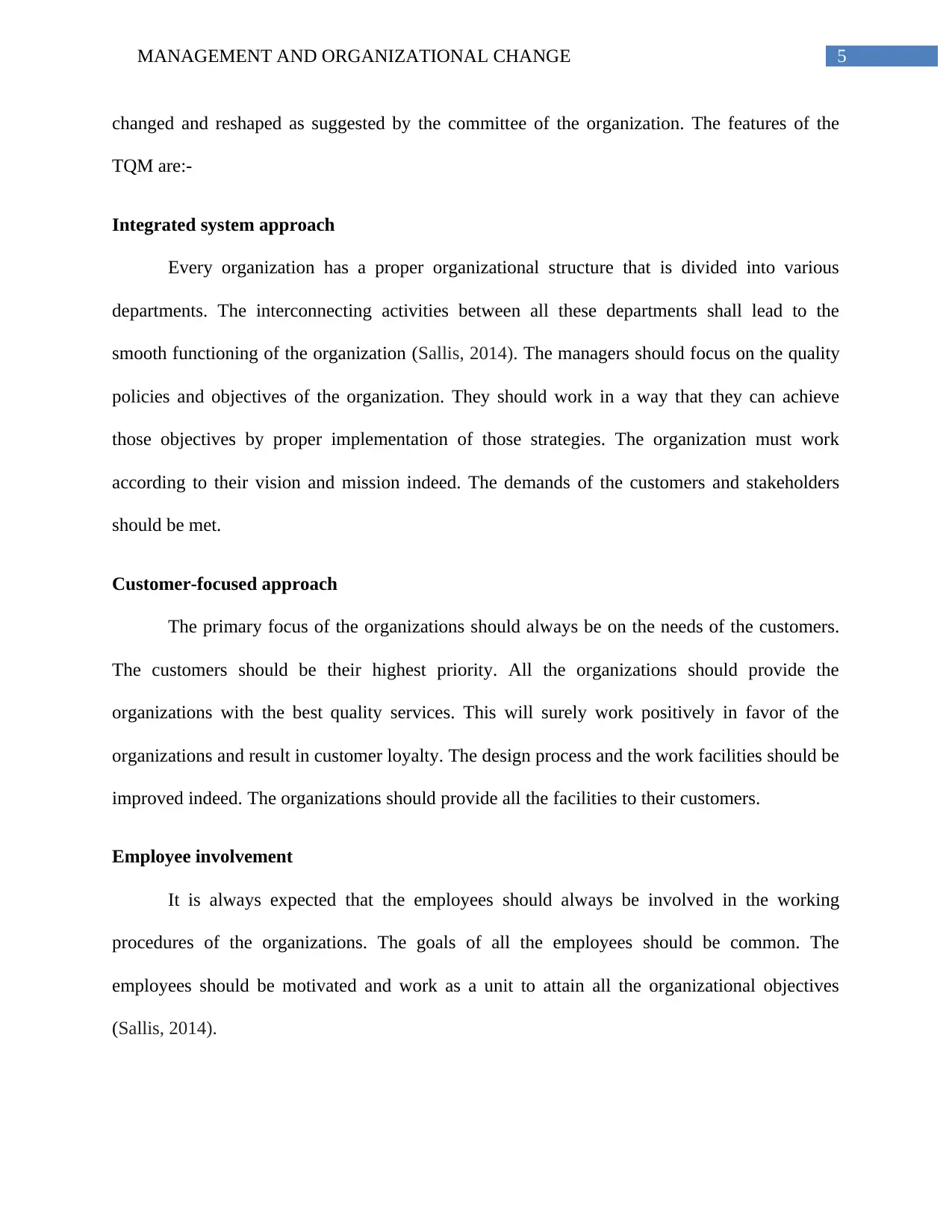
5MANAGEMENT AND ORGANIZATIONAL CHANGE
changed and reshaped as suggested by the committee of the organization. The features of the
TQM are:-
Integrated system approach
Every organization has a proper organizational structure that is divided into various
departments. The interconnecting activities between all these departments shall lead to the
smooth functioning of the organization (Sallis, 2014). The managers should focus on the quality
policies and objectives of the organization. They should work in a way that they can achieve
those objectives by proper implementation of those strategies. The organization must work
according to their vision and mission indeed. The demands of the customers and stakeholders
should be met.
Customer-focused approach
The primary focus of the organizations should always be on the needs of the customers.
The customers should be their highest priority. All the organizations should provide the
organizations with the best quality services. This will surely work positively in favor of the
organizations and result in customer loyalty. The design process and the work facilities should be
improved indeed. The organizations should provide all the facilities to their customers.
Employee involvement
It is always expected that the employees should always be involved in the working
procedures of the organizations. The goals of all the employees should be common. The
employees should be motivated and work as a unit to attain all the organizational objectives
(Sallis, 2014).
changed and reshaped as suggested by the committee of the organization. The features of the
TQM are:-
Integrated system approach
Every organization has a proper organizational structure that is divided into various
departments. The interconnecting activities between all these departments shall lead to the
smooth functioning of the organization (Sallis, 2014). The managers should focus on the quality
policies and objectives of the organization. They should work in a way that they can achieve
those objectives by proper implementation of those strategies. The organization must work
according to their vision and mission indeed. The demands of the customers and stakeholders
should be met.
Customer-focused approach
The primary focus of the organizations should always be on the needs of the customers.
The customers should be their highest priority. All the organizations should provide the
organizations with the best quality services. This will surely work positively in favor of the
organizations and result in customer loyalty. The design process and the work facilities should be
improved indeed. The organizations should provide all the facilities to their customers.
Employee involvement
It is always expected that the employees should always be involved in the working
procedures of the organizations. The goals of all the employees should be common. The
employees should be motivated and work as a unit to attain all the organizational objectives
(Sallis, 2014).
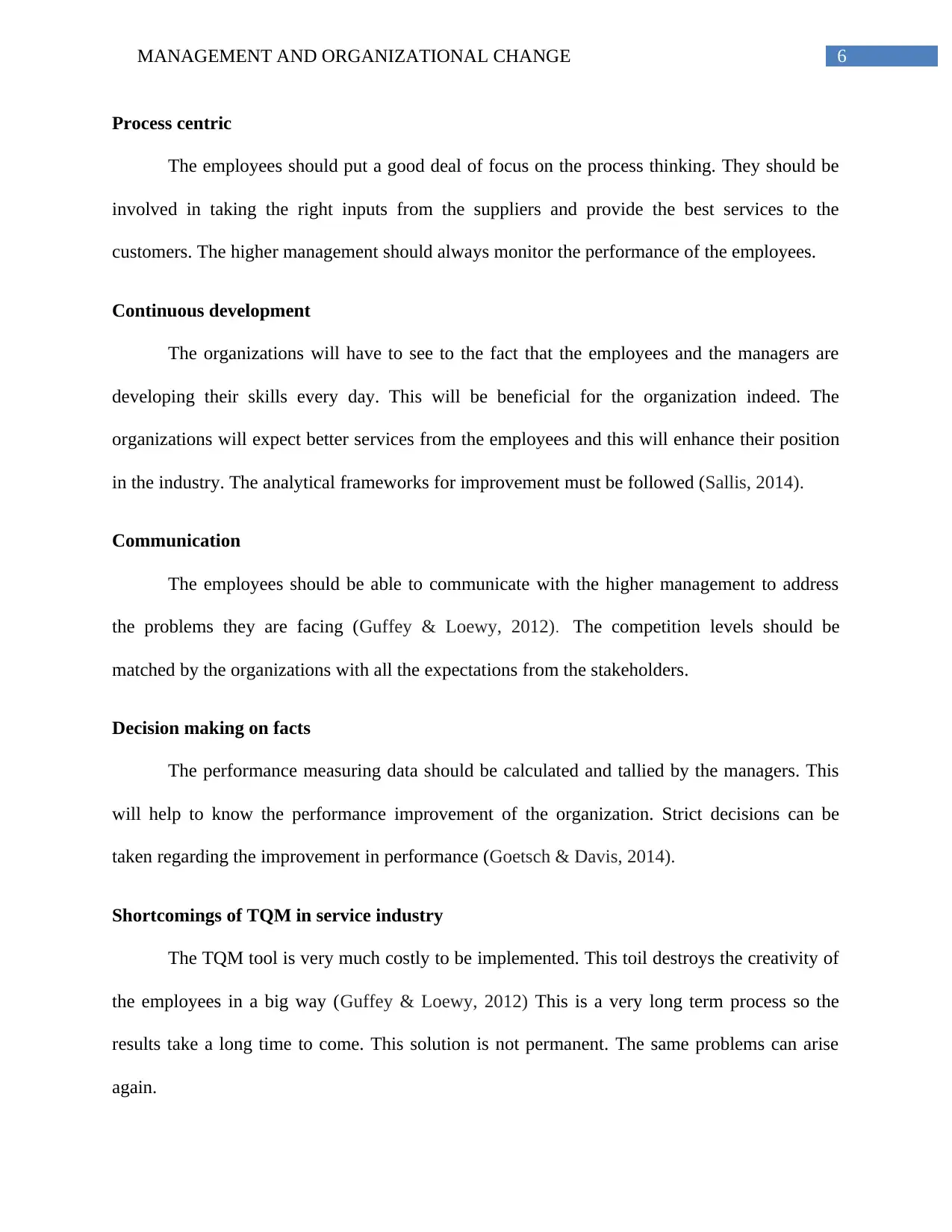
6MANAGEMENT AND ORGANIZATIONAL CHANGE
Process centric
The employees should put a good deal of focus on the process thinking. They should be
involved in taking the right inputs from the suppliers and provide the best services to the
customers. The higher management should always monitor the performance of the employees.
Continuous development
The organizations will have to see to the fact that the employees and the managers are
developing their skills every day. This will be beneficial for the organization indeed. The
organizations will expect better services from the employees and this will enhance their position
in the industry. The analytical frameworks for improvement must be followed (Sallis, 2014).
Communication
The employees should be able to communicate with the higher management to address
the problems they are facing (Guffey & Loewy, 2012). The competition levels should be
matched by the organizations with all the expectations from the stakeholders.
Decision making on facts
The performance measuring data should be calculated and tallied by the managers. This
will help to know the performance improvement of the organization. Strict decisions can be
taken regarding the improvement in performance (Goetsch & Davis, 2014).
Shortcomings of TQM in service industry
The TQM tool is very much costly to be implemented. This toil destroys the creativity of
the employees in a big way (Guffey & Loewy, 2012) This is a very long term process so the
results take a long time to come. This solution is not permanent. The same problems can arise
again.
Process centric
The employees should put a good deal of focus on the process thinking. They should be
involved in taking the right inputs from the suppliers and provide the best services to the
customers. The higher management should always monitor the performance of the employees.
Continuous development
The organizations will have to see to the fact that the employees and the managers are
developing their skills every day. This will be beneficial for the organization indeed. The
organizations will expect better services from the employees and this will enhance their position
in the industry. The analytical frameworks for improvement must be followed (Sallis, 2014).
Communication
The employees should be able to communicate with the higher management to address
the problems they are facing (Guffey & Loewy, 2012). The competition levels should be
matched by the organizations with all the expectations from the stakeholders.
Decision making on facts
The performance measuring data should be calculated and tallied by the managers. This
will help to know the performance improvement of the organization. Strict decisions can be
taken regarding the improvement in performance (Goetsch & Davis, 2014).
Shortcomings of TQM in service industry
The TQM tool is very much costly to be implemented. This toil destroys the creativity of
the employees in a big way (Guffey & Loewy, 2012) This is a very long term process so the
results take a long time to come. This solution is not permanent. The same problems can arise
again.
Paraphrase This Document
Need a fresh take? Get an instant paraphrase of this document with our AI Paraphraser
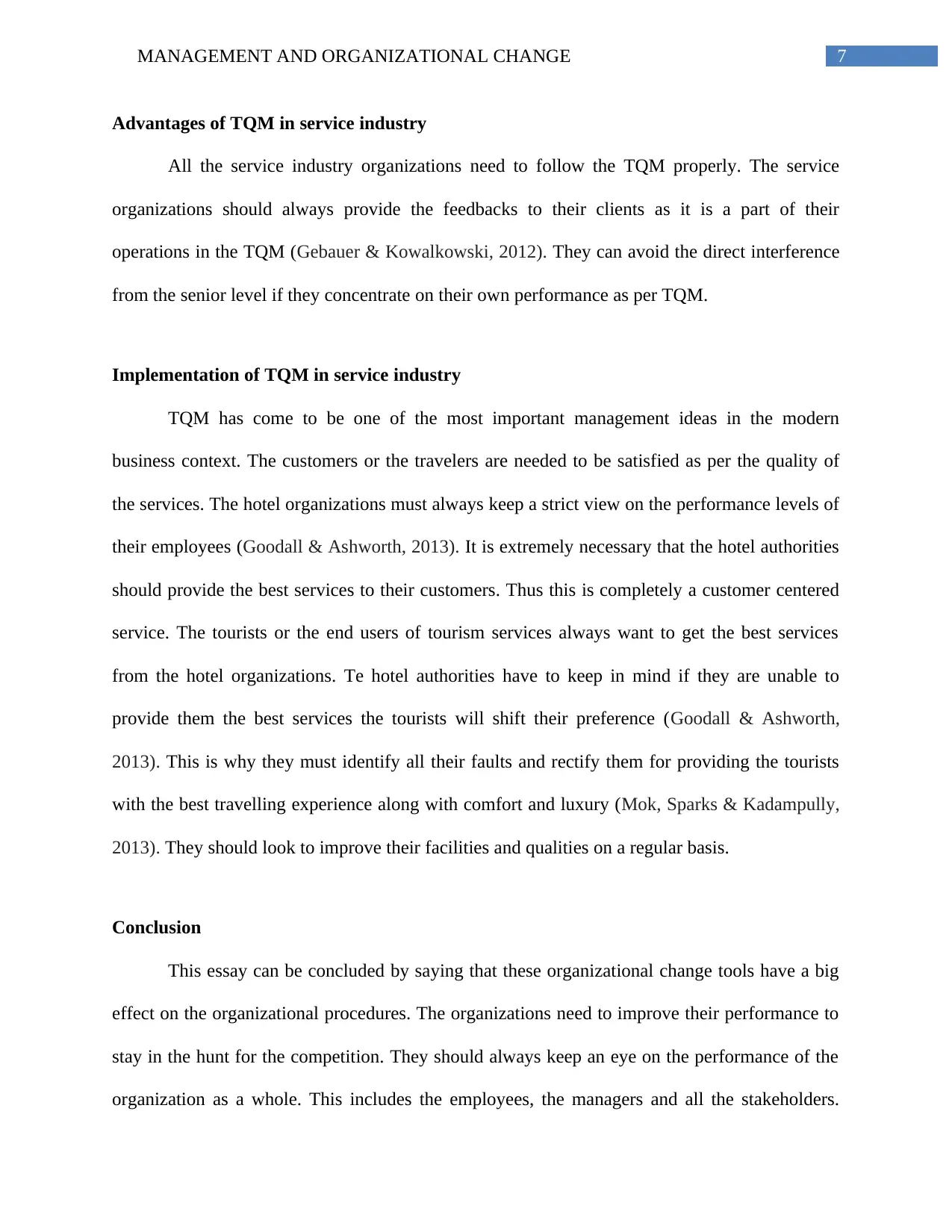
7MANAGEMENT AND ORGANIZATIONAL CHANGE
Advantages of TQM in service industry
All the service industry organizations need to follow the TQM properly. The service
organizations should always provide the feedbacks to their clients as it is a part of their
operations in the TQM (Gebauer & Kowalkowski, 2012). They can avoid the direct interference
from the senior level if they concentrate on their own performance as per TQM.
Implementation of TQM in service industry
TQM has come to be one of the most important management ideas in the modern
business context. The customers or the travelers are needed to be satisfied as per the quality of
the services. The hotel organizations must always keep a strict view on the performance levels of
their employees (Goodall & Ashworth, 2013). It is extremely necessary that the hotel authorities
should provide the best services to their customers. Thus this is completely a customer centered
service. The tourists or the end users of tourism services always want to get the best services
from the hotel organizations. Te hotel authorities have to keep in mind if they are unable to
provide them the best services the tourists will shift their preference (Goodall & Ashworth,
2013). This is why they must identify all their faults and rectify them for providing the tourists
with the best travelling experience along with comfort and luxury (Mok, Sparks & Kadampully,
2013). They should look to improve their facilities and qualities on a regular basis.
Conclusion
This essay can be concluded by saying that these organizational change tools have a big
effect on the organizational procedures. The organizations need to improve their performance to
stay in the hunt for the competition. They should always keep an eye on the performance of the
organization as a whole. This includes the employees, the managers and all the stakeholders.
Advantages of TQM in service industry
All the service industry organizations need to follow the TQM properly. The service
organizations should always provide the feedbacks to their clients as it is a part of their
operations in the TQM (Gebauer & Kowalkowski, 2012). They can avoid the direct interference
from the senior level if they concentrate on their own performance as per TQM.
Implementation of TQM in service industry
TQM has come to be one of the most important management ideas in the modern
business context. The customers or the travelers are needed to be satisfied as per the quality of
the services. The hotel organizations must always keep a strict view on the performance levels of
their employees (Goodall & Ashworth, 2013). It is extremely necessary that the hotel authorities
should provide the best services to their customers. Thus this is completely a customer centered
service. The tourists or the end users of tourism services always want to get the best services
from the hotel organizations. Te hotel authorities have to keep in mind if they are unable to
provide them the best services the tourists will shift their preference (Goodall & Ashworth,
2013). This is why they must identify all their faults and rectify them for providing the tourists
with the best travelling experience along with comfort and luxury (Mok, Sparks & Kadampully,
2013). They should look to improve their facilities and qualities on a regular basis.
Conclusion
This essay can be concluded by saying that these organizational change tools have a big
effect on the organizational procedures. The organizations need to improve their performance to
stay in the hunt for the competition. They should always keep an eye on the performance of the
organization as a whole. This includes the employees, the managers and all the stakeholders.

8MANAGEMENT AND ORGANIZATIONAL CHANGE
This is how the organizations can thrive in this ever changing world of competition. The two of
the most important tools for organizational change have been chosen in this essay. These are the
Total Quality Management (TQM) and High Performance Work Organization (HPWO). These
things are very significant since the features of these tools help to integrate all the basic things of
the organization. The TQM facilities will include the different procedures by which the
performance of the organizations can be measured. This is why the employees should always
care for these things in their best senses. The HPWO tool is also effective as well. This can be
very significant if it is implemented in the manufacturing industry. The TQM tool can be very
much effective if it is implemented in the service industry. The organizations working in the
service industry will be largely benefitted if they can implement the TQM tool. Thus
organizational change will be implemented in the organizations.
This is how the organizations can thrive in this ever changing world of competition. The two of
the most important tools for organizational change have been chosen in this essay. These are the
Total Quality Management (TQM) and High Performance Work Organization (HPWO). These
things are very significant since the features of these tools help to integrate all the basic things of
the organization. The TQM facilities will include the different procedures by which the
performance of the organizations can be measured. This is why the employees should always
care for these things in their best senses. The HPWO tool is also effective as well. This can be
very significant if it is implemented in the manufacturing industry. The TQM tool can be very
much effective if it is implemented in the service industry. The organizations working in the
service industry will be largely benefitted if they can implement the TQM tool. Thus
organizational change will be implemented in the organizations.
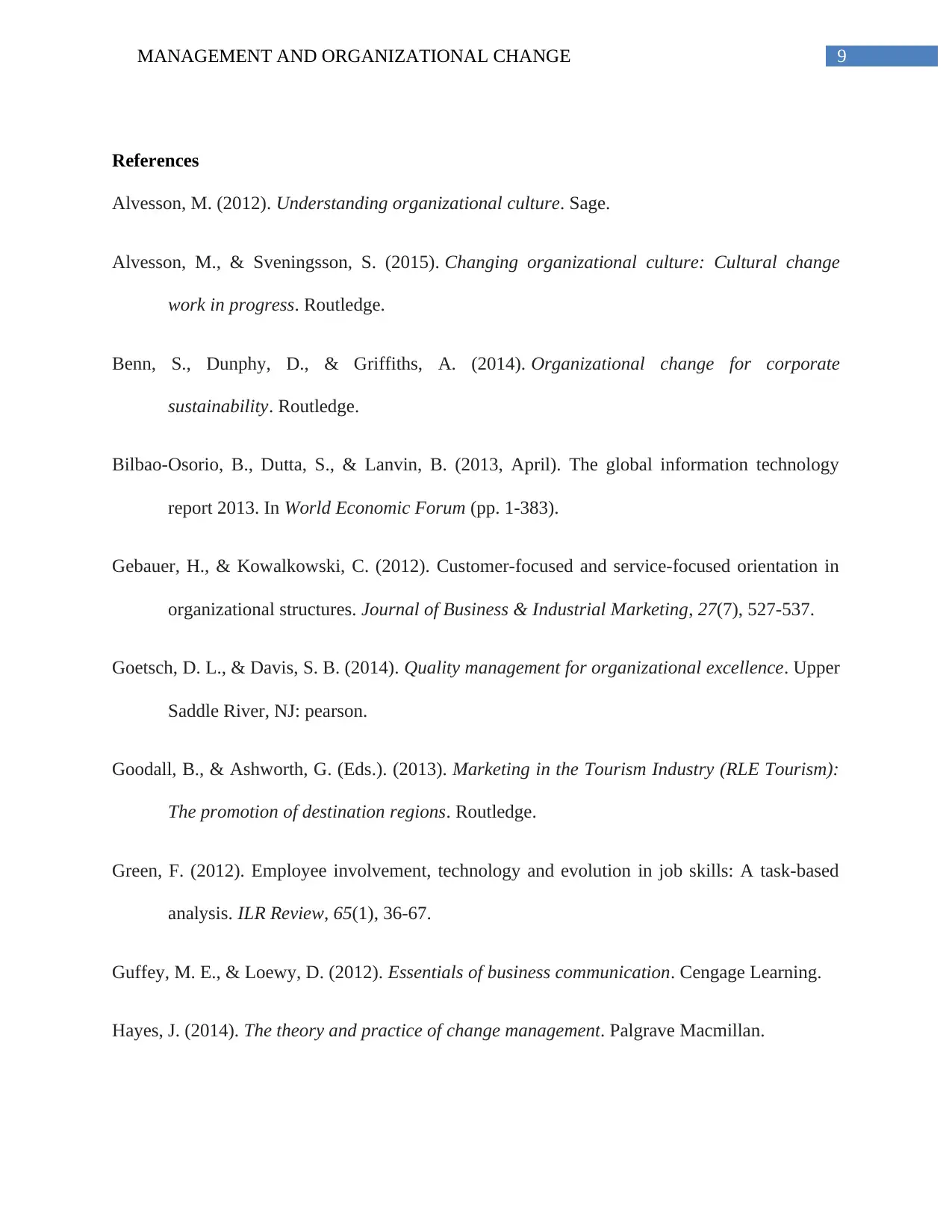
9MANAGEMENT AND ORGANIZATIONAL CHANGE
References
Alvesson, M. (2012). Understanding organizational culture. Sage.
Alvesson, M., & Sveningsson, S. (2015). Changing organizational culture: Cultural change
work in progress. Routledge.
Benn, S., Dunphy, D., & Griffiths, A. (2014). Organizational change for corporate
sustainability. Routledge.
Bilbao-Osorio, B., Dutta, S., & Lanvin, B. (2013, April). The global information technology
report 2013. In World Economic Forum (pp. 1-383).
Gebauer, H., & Kowalkowski, C. (2012). Customer-focused and service-focused orientation in
organizational structures. Journal of Business & Industrial Marketing, 27(7), 527-537.
Goetsch, D. L., & Davis, S. B. (2014). Quality management for organizational excellence. Upper
Saddle River, NJ: pearson.
Goodall, B., & Ashworth, G. (Eds.). (2013). Marketing in the Tourism Industry (RLE Tourism):
The promotion of destination regions. Routledge.
Green, F. (2012). Employee involvement, technology and evolution in job skills: A task-based
analysis. ILR Review, 65(1), 36-67.
Guffey, M. E., & Loewy, D. (2012). Essentials of business communication. Cengage Learning.
Hayes, J. (2014). The theory and practice of change management. Palgrave Macmillan.
References
Alvesson, M. (2012). Understanding organizational culture. Sage.
Alvesson, M., & Sveningsson, S. (2015). Changing organizational culture: Cultural change
work in progress. Routledge.
Benn, S., Dunphy, D., & Griffiths, A. (2014). Organizational change for corporate
sustainability. Routledge.
Bilbao-Osorio, B., Dutta, S., & Lanvin, B. (2013, April). The global information technology
report 2013. In World Economic Forum (pp. 1-383).
Gebauer, H., & Kowalkowski, C. (2012). Customer-focused and service-focused orientation in
organizational structures. Journal of Business & Industrial Marketing, 27(7), 527-537.
Goetsch, D. L., & Davis, S. B. (2014). Quality management for organizational excellence. Upper
Saddle River, NJ: pearson.
Goodall, B., & Ashworth, G. (Eds.). (2013). Marketing in the Tourism Industry (RLE Tourism):
The promotion of destination regions. Routledge.
Green, F. (2012). Employee involvement, technology and evolution in job skills: A task-based
analysis. ILR Review, 65(1), 36-67.
Guffey, M. E., & Loewy, D. (2012). Essentials of business communication. Cengage Learning.
Hayes, J. (2014). The theory and practice of change management. Palgrave Macmillan.
Secure Best Marks with AI Grader
Need help grading? Try our AI Grader for instant feedback on your assignments.

10MANAGEMENT AND ORGANIZATIONAL CHANGE
Katzenbach, J. R., & Smith, D. K. (2015). The wisdom of teams: Creating the high-performance
organization. Harvard Business Review Press.
Lieder, M., & Rashid, A. (2016). Towards circular economy implementation: a comprehensive
review in context of manufacturing industry. Journal of Cleaner Production, 115, 36-51.
Mok, C., Sparks, B., & Kadampully, J. (2013). Service quality management in hospitality,
tourism, and leisure. Routledge.
Oakland, J. S. (2014). Total quality management and operational excellence: text with cases.
Routledge.
Ryu, K., Lee, H. R., & Gon Kim, W. (2012). The influence of the quality of the physical
environment, food, and service on restaurant image, customer perceived value, customer
satisfaction, and behavioral intentions. International Journal of Contemporary
Hospitality Management, 24(2), 200-223.
Sallis, E. (2014). Total quality management in education. Routledge.
Katzenbach, J. R., & Smith, D. K. (2015). The wisdom of teams: Creating the high-performance
organization. Harvard Business Review Press.
Lieder, M., & Rashid, A. (2016). Towards circular economy implementation: a comprehensive
review in context of manufacturing industry. Journal of Cleaner Production, 115, 36-51.
Mok, C., Sparks, B., & Kadampully, J. (2013). Service quality management in hospitality,
tourism, and leisure. Routledge.
Oakland, J. S. (2014). Total quality management and operational excellence: text with cases.
Routledge.
Ryu, K., Lee, H. R., & Gon Kim, W. (2012). The influence of the quality of the physical
environment, food, and service on restaurant image, customer perceived value, customer
satisfaction, and behavioral intentions. International Journal of Contemporary
Hospitality Management, 24(2), 200-223.
Sallis, E. (2014). Total quality management in education. Routledge.
1 out of 11
Related Documents
Your All-in-One AI-Powered Toolkit for Academic Success.
+13062052269
info@desklib.com
Available 24*7 on WhatsApp / Email
![[object Object]](/_next/static/media/star-bottom.7253800d.svg)
Unlock your academic potential
© 2024 | Zucol Services PVT LTD | All rights reserved.





